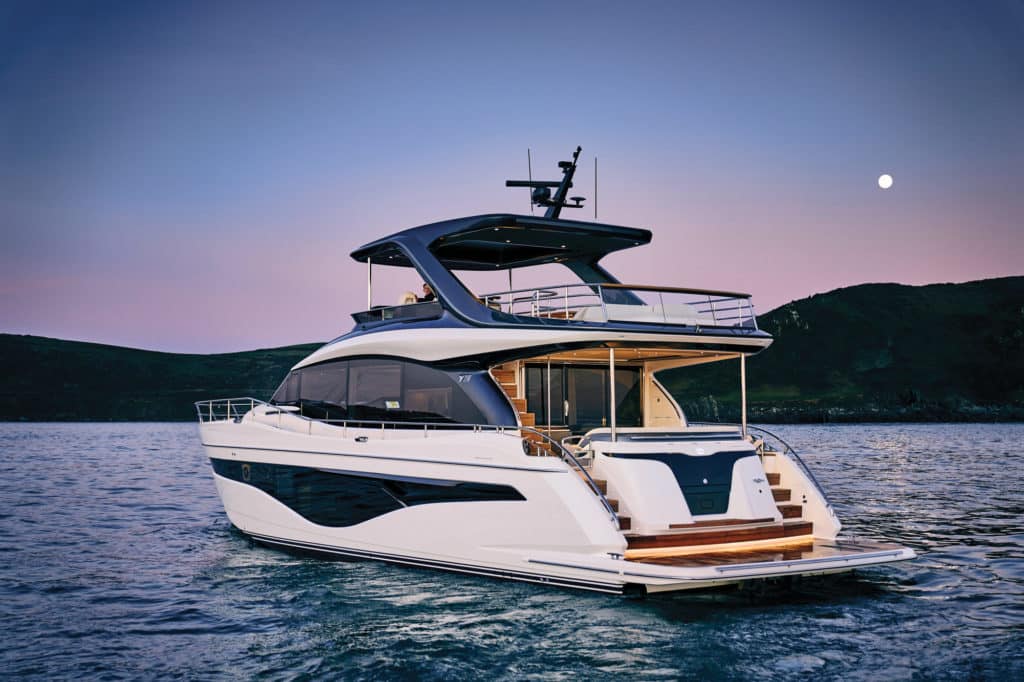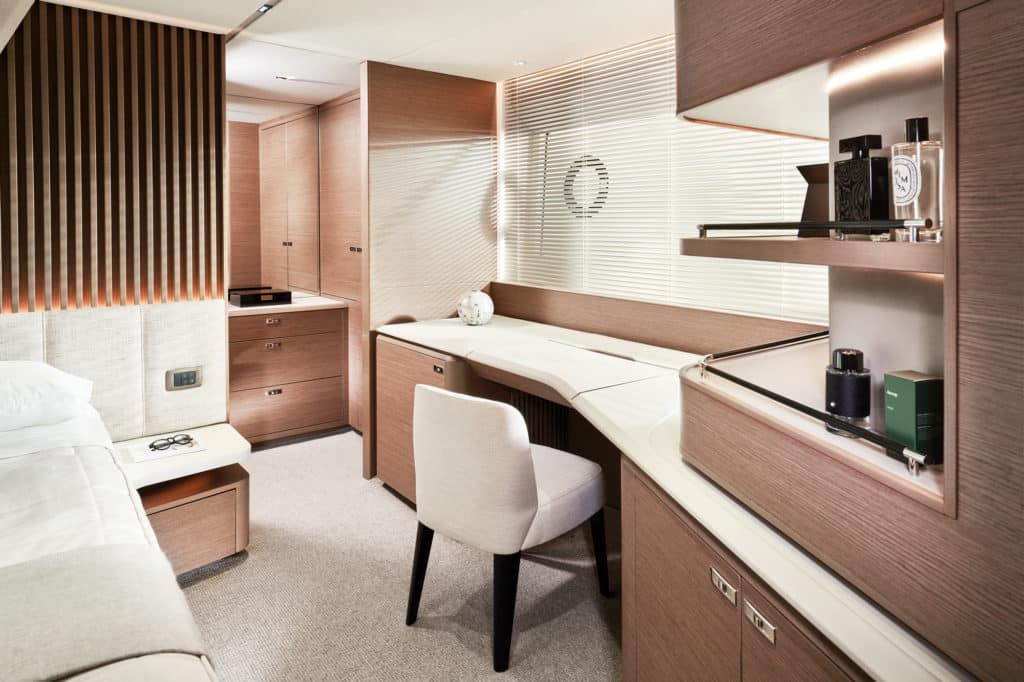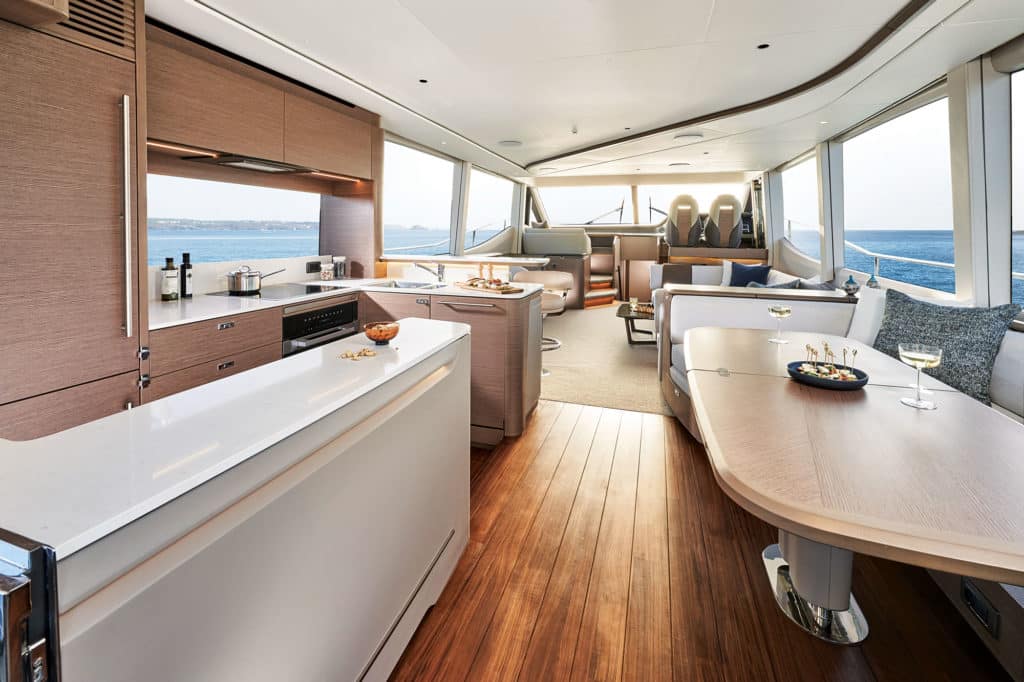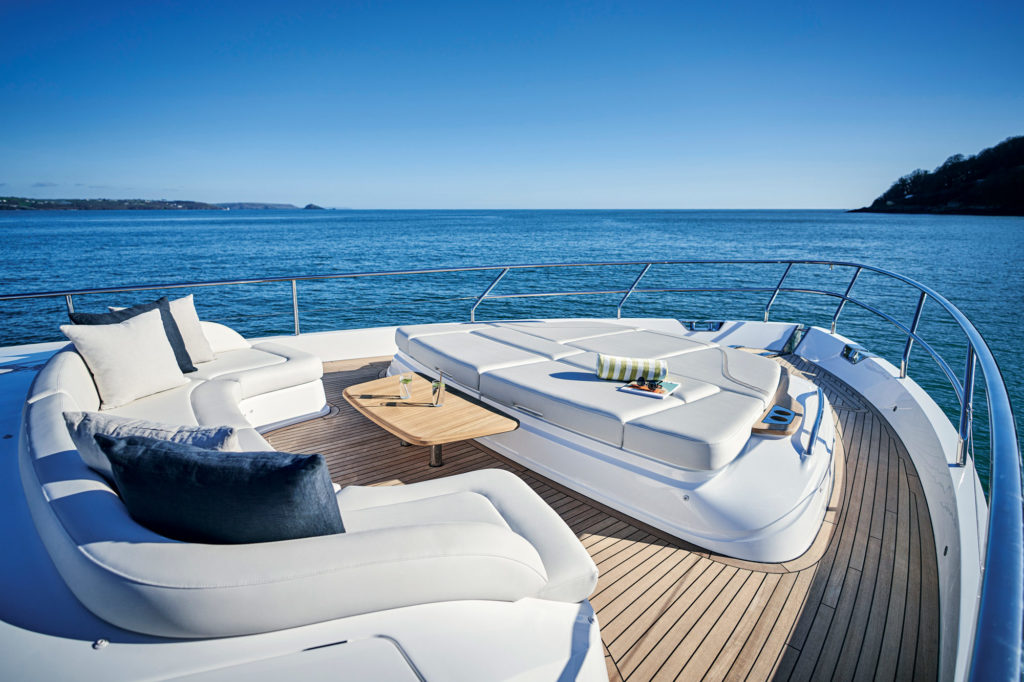
The Gulf Stream was cranky after a 40-knot cold front had blown through the previous day, leaving a confused sea. Even so, the Princess Yachts Y72 cruised across the angry ocean at 34 knots, up sea and cross sea. There were no teeth-jarring slams—just a welcoming, soft ride. And, just as good, nary a creak or squeak from anywhere aboard.
The good sea manners of the Y72 are certainly the result of naval architect Bernard Olesinski’s background of racing powerboats in the English Channel, a body of water with even fewer benign days than the Gulf Stream. Ferrari designers Pininfarina pitched in on the yacht’s exterior lines.
The Y72’s detailing and small touches are superyacht-level, from the stitched Livorno Stone leather countertops to the redundant air-conditioning systems neatly racked in the engine room.
At the stern, a hydraulic swim platform can lift a Williams Sportjet 395 tender, and there’s a waist-level stowage locker with charging ports for Seabobs. A passerelle is hidden in the portside stairs to the aft deck, where a U-shaped dinette with a table awaits.

The galley is aft in the salon with a lifting window that opens to the cockpit. This window is the first clue that the Y72 balances an elegant interior with alfresco fun. The galley is a step down, allowing for a full-height fridge, and an aft-facing, L-shaped dinette is opposite to include cockpit guests. Forward, the salon is geared for family entertainment, with a 55-inch pop-up TV and two sofas.
The skipper is on a raised dais for unobstructed visibility, facing triple monitors that include a touchscreen Boening for all ship’s systems. This Y72 also had Garmin’s Surround View camera system, which enables 360-degree views to help with docking. The twin helm seats are very Aston Martin, with diamond stitching and headrests, and a pantograph door allows the skipper to step onto the side deck, handle lines and communicate with crewmembers. Opposite the helm is a raised settee for guests, with a swing-out table for drinks or a laptop.
Another mega-yacht feature is the private stairwell to the full-beam master stateroom. The en suite head is aft, providing an extra layer of soundproofing from the engine room. A leather-topped vanity is to port, and a love seat is opposite with hull-side windows for light and ocean views. Headroom is 6 feet, 4 inches. A dressing area has closets and dressers, while the head has twin vanities and a shower.

Throughout the Y72, design cues from its larger siblings tie the decor together, including vertical wood slat effects, walnut paneling and linen wall coverings.
Forward, via separate stairs from the salon, are the guest staterooms, including an island VIP berth in the bow with an en suite head. Two additional staterooms have twins that slide into doubles. Aft, accessed from the transom or via a deck hatch, is a crew cabin with two berths, a head and stowage.
In fact, stowage is one thing that impressed me throughout this yacht: Every cranny under sofas or berths or behind bulkheads is viable stowage.

Up on the flybridge is a dining table with a removable center section, so those seated inside can leave. A wraparound settee is opposite the twin-seat helm. A wet bar with a grill, sink, fridge and ice maker serves the area. The aft deck has a sun pad that can be replaced with a davit for a tender or a spa. Overhead on this Y72 was an optional hardtop with a louvered sunroof.
Follow the superyacht-style oval rails forward to the foredeck, and guests will find a third alfresco space, where a convertible sun pad offers bronzing or seating to encircle the dining table.
The engine room is reached via the crew quarters and through a generator flat. Inside are a pair of 22.5 kW Onan gensets (one is standard) and the hydraulics package. Room is allotted for a Seakeeper stabilizer, but the yacht I got aboard had Sleipner Vector Fins. Standard power for the Y72 is twin 1,400 hp MAN V-12 diesels. The Y72 I got aboard had optional 1,650 hp MAN diesels.
Underway, the Y72 shouldered aside the Gulf Stream with impunity, and it’s here that I found the Vector Fins particularly useful. The faster we went—up to a top speed of 34 knots—the smoother the ride. At 27 knots, the decibel meter registered 70 in the salon. That’s about the equivalent of a dishwasher.
The Princess Yachts Y72 is the smallest in the builder’s Y range, which also includes 78-, 85- and 95-foot models, but it punches angry seas far above its weight while offering owners and guests superyacht-level living inside and out.
Seeing is Relieving
Garmin Surround View steals a page from automotive park-assist systems but goes one better. This 360-degree and bird’s-eye view uses six 1080p cameras mounted through the yacht’s hull. Feeds from those cameras are stitched into a helm display for total situational awareness when docking or maneuvering (read: no blind spots). A “bumper zone” can be set to assist the skipper, and distance markers allow skippers to make decisions easier. With full night vision, this video guidance is a breakthrough. It can also serve as a warning system against unseen objects and debris in the water.
Stable as a Table
Princess Y72 owners have a choice between the Seakeeper gyrostabilizer and Sleipner Vector stabilizing fins. There is room allotted for the Seakeeper in the generator lazarette, but the Y72 I got aboard had the Sleipner fins for full roll control, even at top speed in rough water. The curved Sleipner fins are said to be 50 percent more efficient than flat fins and are efficient at anchor. The advanced hydrodynamic fin shape has less resistance, helping to reduce fuel consumption.
Take the next step: princessyachtsamerica.com









